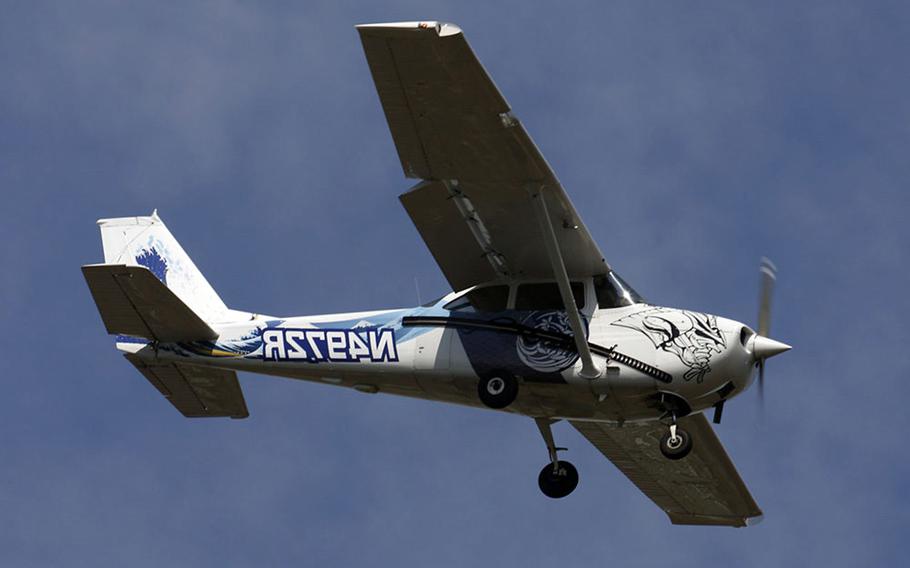
A Cessna 172 owned and operated by the Aero Club at Yokota Air Base, Japan. The club plans to replace the aging planes with Diamond DA40s. (U.S. Air Force)
YOKOTA AIR BASE, Japan — The Aero Club at this airlift hub in western Tokyo is purchasing new Diamond DA40s to replace its aging Cessna 172s.
The first pair of the 2023 model single-engine aircraft are expected to arrive in the summer, and the club plans to purchase a third next year.
A major reason for the upgrade is limited access to ethanol-free fuel for the club’s Cessnas, which are 50-57 years old, Aero Club manager Ray Brannam told Stars and Stripes on Tuesday at the club office.
“The sole supplier that’s giving us the alcohol-free gas is saying that there’s a definite end-of-life and they’re going to stop,” he said. “We’re their only customer buying that type of gas.”
The DA40s use cheaper jet fuel, which Brannam said costs around $3 per gallon. The alcohol-free fuel costs between $7 and $9 per gallon.
Diamond Aircraft Industries, an Austrian company, was bought in 2017 by Wangfeng Aviation, a Chinese company, according to Diamond’s website.
Brannam said the club plans to replace three of its four Cessnas. The DA40s cost the club $650,000 each, money the club raised through its operations, which include flight instruction and fly-over tours of Tokyo.
“Right now, we have four aircraft,” Brannam said. “One of them was more or less so we could take one down for maintenance and not impact our ability to meet our current demand. The new aircraft, they’re new, they don’t require the amount of maintenance that the older aircraft require, so three are fine.”
The club plans to transfer two of its Cessnas to other aero clubs and put the third up for auction in the United States. It hasn’t been decided which clubs will get the old planes.
The Air Force hosts 17 Aero Clubs, but only two are on overseas bases and both are in Japan: Yokota and Kadena Air Base on Okinawa.
Overall, interest within the American public for general aviation slumped between 2008 and 2016, when the number of active pilots of all types fell from 613,746 to 584,632, according to the Federal Aviation Administration. Private airplane pilots, the basic certification that Aero Club training provides, fell from 213,635 to 156,058 in the same period.
Pilot numbers started to grow after 2016 and by 2022 stood at 756,928, according to FAA. The number of active private pilots likewise rose to 164,090.
The Aero Clubs are open to service members and their dependents, Department of Defense civilians, members of the Civil Air Patrol and retirees with base access. The club provides them the opportunity to earn their pilot’s license, which can be a stepping stone to becoming a pilot for the Air Force or commercial airlines.
The FAA requires a minimum 40 hours of flight instruction for a private pilot certificate, but students typically need 50-60 hours before they’re ready for the flight test, Brannam said. That costs about $10,000 to $14,000 through the Aero Club, a bargain compared to the cost at commercial flight schools, he said.
“I think one of the biggest things we provide is the training for people to go into the Air Force as pilots,” Brannam said. “A number, not a huge number, but a number of these people go on to get pilot slots in the Air Force, so we’re actually feeding the pilot shortage a little bit.”
The Air Force reported a shortfall of about 1,900 pilots last year, according to The Associated Press on Feb. 23.
In 2017, then-President Donald Trump signed an executive order allowing the Air Force to recall up to 1,000 retired pilots to serve as instructors and staff.
Many Aero Clubs are still recovering after losing members and flight time during the COVID-19 pandemic.
Pandemic restrictions cost the clubs their members and hours of flight time, which is their primary source of revenue. Aero Clubs are non-appropriated fund activities, which means they must generate money to support themselves.
“COVID really did curtail how much flying we were doing; we’re recovering from that now,” Brannam said. “If it had kept on for a couple more years, I’m sure we wouldn’t be here.”